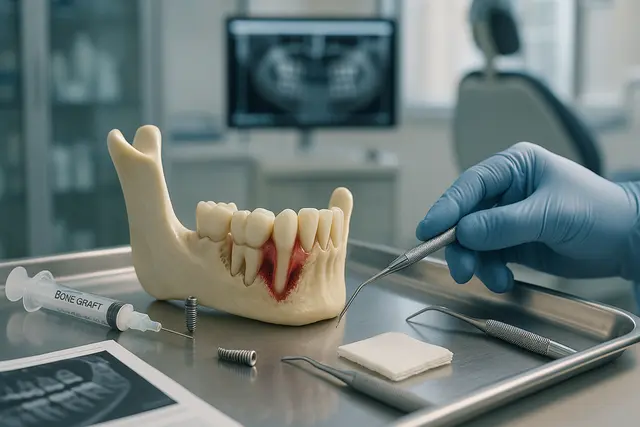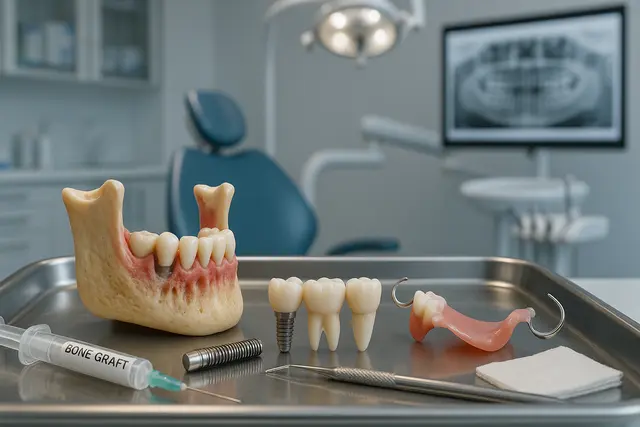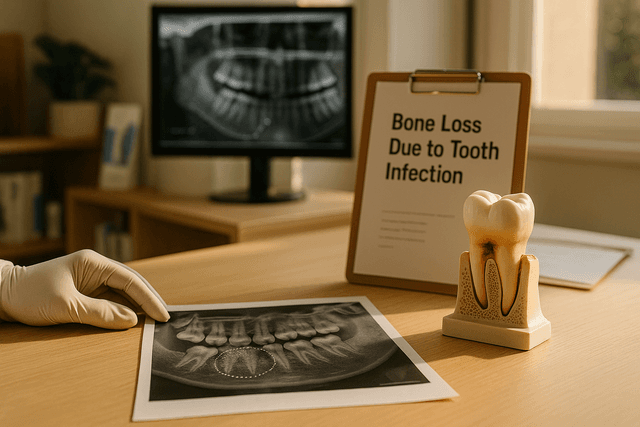Oral Health
5 min read
Sep 25, 2025
Understanding Bone Loss in Teeth: Causes and Treatments That Work
Bone loss in teeth is a silent threat that can compromise your smile, facial structure, and overall oral health. While it often goes unnoticed in the early stages, it can lead to serious consequences if left untreated. Understanding what causes dental bone loss, and how to prevent or manage it, is key to maintaining a strong, healthy foundation for your teeth.

You might not think much about the bone beneath your teeth, until something starts to go wrong. Bone loss in teeth isn’t just a dental buzzword; it’s a real condition that can change the shape of your smile, the health of your gums, and your overall confidence. Whether you've already noticed signs of bone loss or you're just curious (and smart) enough to learn how to prevent it, you’re in the right place.
Bone Loss Can Sneak Up on You
Bone loss around the teeth is one of those things you don’t notice right away. It doesn’t hurt like a toothache or flash warning signs like bleeding gums, at first. But behind the scenes, the bone that holds your teeth in place (also called alveolar bone) can slowly erode, leading to serious dental issues down the line.
The loss of bone may not just affect your smile, but it can also mess with how your teeth line up, how your face looks, and even how you chew. Bone loss in the jaw doesn't just happen overnight, either, it’s usually the result of years of neglect, poor oral hygiene, or specific health issues that erode the bone supporting the teeth.
What Can Cause Bone Loss Around the Teeth
If you’re wondering what could cause bone loss, it’s not just one culprit. There are a few:
Gum disease is the most common cause of bone loss. When bacteria sneak below the gum line, they start destroying the tissue and bone that holds teeth in place.
Tooth loss or missing teeth can lead to bone resorption, where the body starts reabsorbing the bone that’s no longer supporting a tooth.
Tooth extraction without replacing the tooth can speed up bone deterioration.
Periodontitis, a more severe form of gum disease, leads to bone loss fast if untreated.
Infections, trauma, or tumors in the jawbone can damage bone tissue.
Poorly fitting dentures or bridges that don’t stimulate the jawbone can cause progressive loss over time.
Lack of regular dental visits or good oral hygiene at home often allows problems to go undetected.
In short, anything that removes or reduces stimulation to the bone supporting your teeth can lead to bone loss.
The Symptoms and Causes of Bone Loss in Teeth
So, what are the early signs of bone loss? It's not always obvious. But there are a few things to watch out for:
Loose teeth or a change in how your teeth fit together
Receding gums, or teeth that look longer than they used to
Chronic bad breath or bad taste
Gaps forming between teeth
Facial changes, especially if bone loss in the jaw becomes more advanced
Discomfort when chewing, or sensitivity you didn’t have before
Knowing these symptoms and causes means you can catch the problem earlier, before it leads to tooth loss or major bone deterioration.
How to Prevent Bone Loss From Happening
Let’s be real, once bone is lost, it’s tricky to grow back. That’s why prevention is the name of the game. Here's what actually helps prevent bone loss:
Brushing and flossing daily. It’s basic, but it works.
Good oral hygiene at home. Use the right toothpaste, rinse, and be consistent.
Regular dental visits and dental cleaning to catch problems early.
Deep cleanings if needed to stay ahead of gum disease.
If you’ve had a tooth extraction, don’t wait to explore replacement options like a dental implant.
Avoid smoking, it absolutely wrecks bone health.
Manage conditions like diabetes, which may lead to bone loss more quickly.
Consistent dental checkups aren’t just about sparkling teeth. They help detect bone loss early and stop small issues from becoming big, expensive ones.
When Bone Loss Strikes a Tooth: What You Need to Know
A single tooth can cause a domino effect. Once you lose one, the surrounding teeth and gums shift. Worse, the bone that supports your teeth begins to shrink because it's not getting the stimulation it needs.
And yes, this means even one missing tooth can lead to bone loss in the jaw. The areas of bone that don’t get regular pressure, like from chewing, can weaken and vanish over time.
How to Rebuild Bone and Restore Your Smile
Here’s the good news: while we can’t completely reverse dental bone loss, we can treat it, and sometimes, we can restore lost bone.
Let’s break down what works.
Getting a Dental Implant After Tooth Loss
If you’ve lost one or more teeth, getting a dental implant can do more than just restore your smile. It helps rebuild bone and keep the bone that supports your teeth healthy. Implants stimulate the jawbone, preventing that dreaded gradual deterioration of bone.
Bone Graft Treatment
A bone graft is used to restore bone density and volume in areas where it's already been lost. Grafting bone might sound intense, but it’s a safe, effective method to help restore bone structure and support future placement of dental implants.
Your dentist may use natural or synthetic bone tissue, depending on how much bone you’ve lost and where. This helps create a stable base to support new teeth in place, or to prep for implants or a dental bridge.
Treating Periodontitis to Stop Bone Loss
Got periodontitis? Then addressing it is priority number one. Treating periodontitis with deep cleanings, antibiotics, and sometimes surgical treatments is used to remove bacteria and stop it before it destroys more tissue and bone that holds teeth.
Once the infection is under control, your dentist will focus on preserving or rebuilding the bone that holds your teeth.
Why Dental Bone Loss Matters More Than You Think
Here’s the thing: dental bone loss affects more than just your mouth. It can change your facial shape, speech, digestion, and self-confidence. It’s not just about vanity, it’s about oral health and quality of life.
And when the bone structure weakens, it compromises everything above it: the teeth and gums, your natural teeth, even your opposing tooth structure (meaning, the tooth above or below the gap).
When you lose one tooth and don’t replace it, the supporting gum tissue and bone can shrink, leading to the loosening and subsequent loss of more teeth. It becomes a cycle that’s hard to stop without intervention.
Catch the Early Signs of Bone Loss Before It’s Too Late
If you experience bone loss, you're not alone. Millions of people deal with it, often without knowing at first. That’s why it's key to detect bone loss early, treat gum and bone issues proactively, and keep those regular dental checkups.
With the right steps, you can keep the bone in place, protect your healthy bone, and stop the slow creep of bone resorption before it chips away at your confidence.
What Causes Bone Loss Around the Teeth?
Bone loss around the teeth is primarily caused by gum disease, particularly periodontitis. When bacteria reach below the gum line, they begin to destroy the bone and tissue that support your teeth. Other common causes include missing teeth, untreated tooth extractions, infections, trauma, poorly fitting dental restorations, and lack of oral hygiene. All of these reduce stimulation to the jawbone, leading to gradual resorption.
What Are the Early Signs of Dental Bone Loss?
Early signs of bone loss can be subtle, but common symptoms include loose or shifting teeth, receding gums, new gaps between teeth, bad breath, and facial changes. Discomfort while chewing and teeth appearing longer than before are also warning signs. Because these symptoms can develop slowly, regular dental checkups are essential for early detection.
Can Bone Loss in Teeth Be Treated or Reversed?
While bone loss can’t always be completely reversed, it can often be treated and stabilized. Bone grafts can restore lost bone density, and dental implants help stimulate bone to prevent further loss. Deep cleanings and periodontal treatments can halt disease progression. In many cases, these combined approaches can preserve or rebuild enough bone to restore oral function and support new teeth.
How Can You Prevent Bone Loss From Happening?
Preventing bone loss starts with consistent oral hygiene, brushing, flossing, and using dentist-recommended products. Regular dental cleanings, prompt treatment of gum disease, and replacing missing teeth with implants help maintain bone structure. Lifestyle habits like avoiding smoking and managing conditions such as diabetes also play a critical role in keeping jawbone tissue healthy.
Read Next
Related Posts

Oral Health
Tooth Replacement Options to Prevent Bone Loss
Losing a tooth isn’t just about appearance, it can have a lasting impact on your oral health, jawbone strength, and overall quality of life. When teeth go missing, the jawbone begins to shrink, which can change your bite, your facial structure, and even your confidence. Fortunately, modern dentistry offers several effective solutions to replace missing teeth and prevent further bone loss.
4 min read
Sep 26, 2025

Oral Health
Bone Loss Due to Tooth Infection Explained: What It Means for Your Oral Health
A tooth infection isn’t just about pain, it can quietly damage the tissues around a tooth and even erode the jawbone that supports your smile. This guide explains how infections start, why they can lead to bone loss, the warning signs to watch for, and the treatments that can stop the spread and rebuild lost support.
5 min read
Sep 25, 2025

Oral Health
What Is Mewing Trend? Origins, Science, and Results
From TikTok tutorials to teen slang, "mewing" has taken over the internet as the latest beauty and wellness craze. But beyond the social media hype, what exactly is mewing, and can it really transform your face or improve your jawline? This curious trend centers on one simple thing: where you rest your tongue.
4 min read
Sep 08, 2025
Don’t have time to research every dentist around you?
See why 30k+ patients trusted us